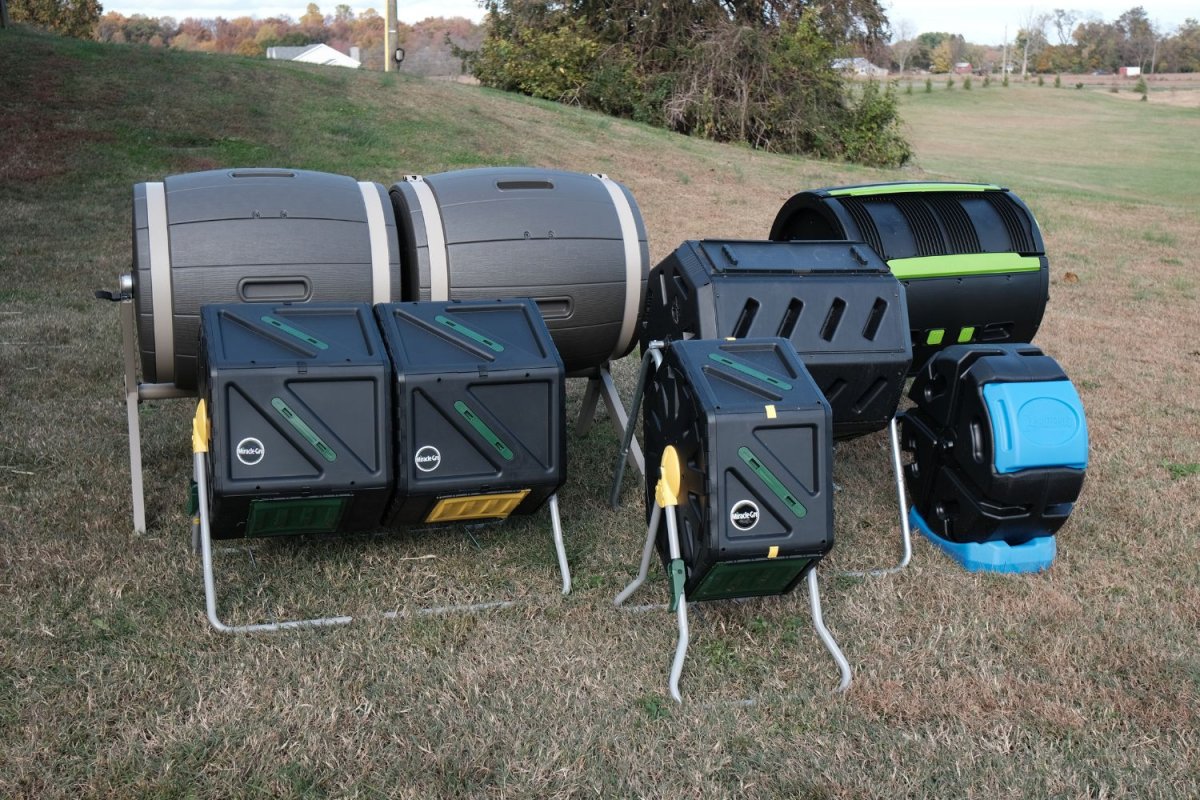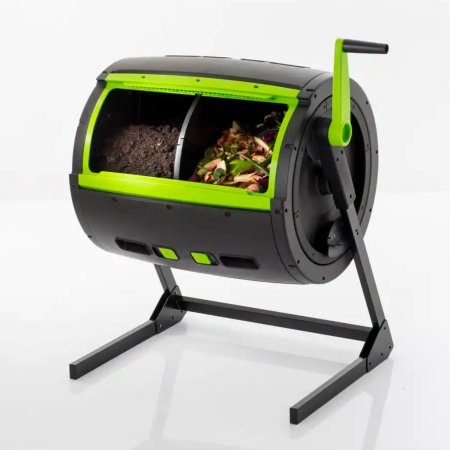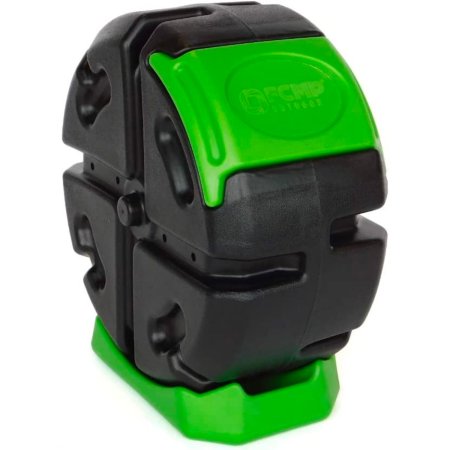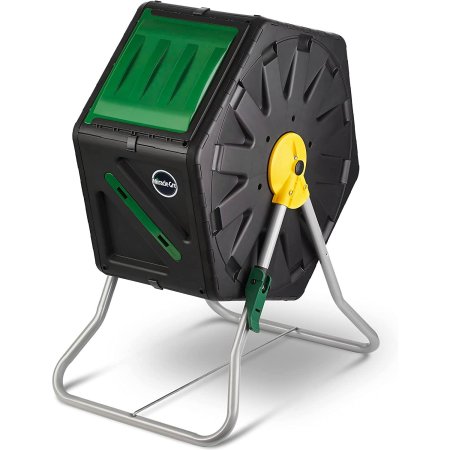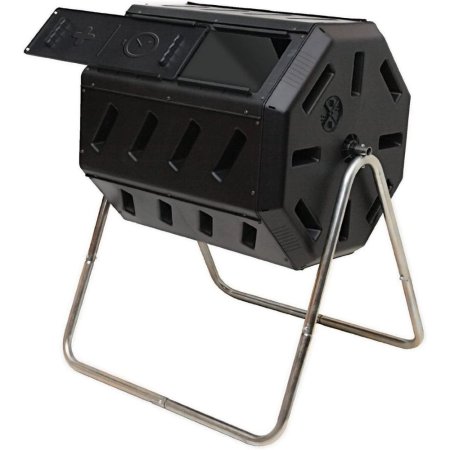We may earn revenue from the products available on this page and participate in affiliate programs. Learn More ›
Best Overall
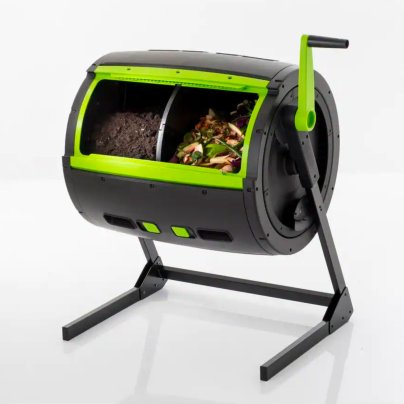
RSI Maze 65-Gallon Compost Tumbler
Best Bang for the Buck
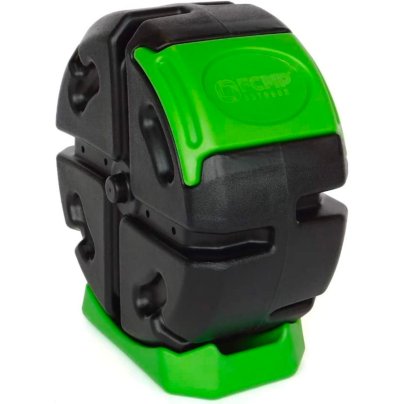
FCMP Half-Size Rolling Composter
Best Small
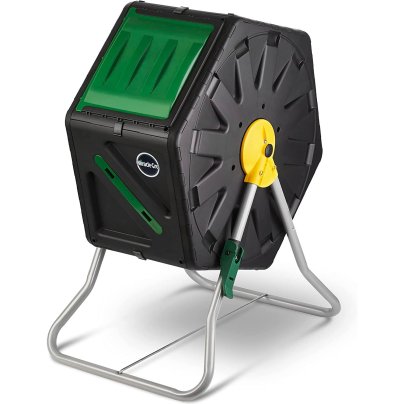
Miracle-Gro Tumbling Composter
Composting has numerous benefits, and having a compost tumbler makes the process even easier. In addition to recycling kitchen, lawn, and garden waste into a helpful soil amendment, composting helps keep significant amounts of organic waste out of landfills. As lawn care and gardening enthusiasts, we wanted to find out just how easy these contraptions made the task, so we tested several. For 8 weeks, we filled and turned tumblers, yielding more than 100 pounds of plant-loving compost.
After testing, we like the RSI Maze 65-Gallon Compost Tumbler best for its overall ease of use and smart design, but it’s not the only great option Ahead, learn more about how these products fared in testing, and what considerations to keep in mind when shopping for the best compost tumbler.
- BEST OVERALL: RSI Maze 65-Gallon Compost Tumbler
- BEST BANG FOR THE BUCK: FCMP Half-Size Rolling Composter
- BEST SMALL: Miracle-Gro Tumbling Composter
- BEST LARGE: Lifetime 100-Gallon Double-Bin Rotating Composter
- BEST MIDSIZE: FCMP IM4000 Dual-Chamber Tumbling Composter
| RSI Maze 65-Gallon Compost Tumbler | FCMP Half-Size Rolling Composter | Miracle-Gro Tumbling Composter | Lifetime 100-Gallon Double-Bin Rotating Composter | FCMP IM4000 Dual-Chamber Tumbling Composter | |
| Capacity | 65 gallons | 19 gallons | 18.5 gallons | 100 gallons | 37 gallons |
| Dimensions | 44.5 x 41.3 x 30 inches | 24 x 12 x 24 inches | 29.5 x 17 x 23.5 inches | 43.3 x 65 x 31 inches | 36 x 30 x 28 inches |
| Weight | 54 pounds | 15 pounds | 10.6 pounds | 85.8 pounds | 26.5 pounds |
Our Top Picks
We tested each of these composters, from assembly to everyday use, to determine the best picks for both small and large home gardens.
Best Overall
RSI Maze 65-Gallon Compost Tumbler
Product Specs
- Capacity: 65 gallons
- Dimensions: 44.5 inches tall by 41.3 wide by 30 inches deep
- Weight: 54 pounds
What We Like
- Easy to turn even when full
- Ample size suits medium to large gardens and planters
- Dual chambers allow users to fill and create compost consistently
What We Don’t Like
- Heavy weight makes it difficult to move
- May take 2 hands to crank when full
The RSI Maze Compost Tumbler makes controlling the bin simple and smooth—even when fully loaded—with a geared handle and ratchet lock. The bin features air vents on all sides and large sliding covers that simplify loading and unloading. The dual-chamber design facilitates a consistent flow of garden waste in and compost out. This is a suitable size for medium to large gardens and landscapes.
The 65-gallon (8.69-cubic-foot) bin is made of UV-protected high-impact plastic. The frame is made of rust- and corrosion-resistant zinc-coated steel. It offers 15 inches of ground clearance for unloading compost via a cart.
We loved the size of this composter as well as its hand crank, which made it easy to turn even when the composter was full. We filled it with organic vegetable and fruit scraps, dry leaves, and dry grass.
The crank was a unique feature of all the composters we tested, as no other composter had a hand crank and needed to be turned by physically trying to roll the barrels. In addition, the crank made it easy to “stop” the bin in a position where it was easiest to empty it, which made emptying easy as well.
The crank combined with the composter’s size and durability made this product our Best Overall pick. The doors were also easy to operate and the frame was very sturdy. While the composter takes a couple of people to assemble, it can be used with one hand once built.
One con to the composter was its weight, so users should be mindful of where they want to place it. Once it’s full of compost, it’s difficult to move.
What our tester says: “I found this product to be high quality. It’s very durable, thanks in part to its rust-resistant zinc coating. Additionally, it’s relatively simple to assemble, and it’s easy to use.” —Jenn Ryan, Product Reviews tester and writer
Read our full review: RSI Maze Two-Stage Compost Tumbler
Get the RSI compost tumbler at The Home Depot, Lowe’s, or Tractor Supply Co.
Best Bang for the Buck
FCMP Half-Size Rolling Composter
Product Specs
- Capacity: 19 gallons
- Dimensions: 24 inches tall by 12 inches wide by 24 tall inches deep
- Weight: 15 pounds
What We Like
- Super-simple assembly
- Can be placed virtually anywhere
- Lightweight for easy to transport
What We Don’t Like
- Close to ground, making bin difficult to turn
- Requires more turning than many other composters
- Needs to be picked up to be emptied
The FCMP Half-Size Rolling Composter is a good size at an affordable price for one or two people who generate only a few compostable items. The ground-rolling design gives this unit a low profile that easily tucks away in small spaces, such as a balcony, patio, or garage. Built-in ergonomic handholds help make rolling less awkward. Aeration holes and deep fins break up clumps inside the chamber to maximize oxygen penetration.
The 19-gallon (2.5-cubic-foot) bin is made of recycled UV-inhibited BPA-free polyethylene. To speed decomposition, the manufacturer recommends turning the bin about twice a day.
The assembly of this product couldn’t have been easier. The composter came almost completely assembled—all we needed to do was place it on the stand and slide the door on. Although we loved the size and portability of this composter, it was too small for a large garden and would make a better option for urban composters, those with a small garden, or those who want to use compost for indoor or potted plants.
During testing, the composter needed to be turned frequently and, for balance, using two hands was best. We also found it challenging to turn because it is not attached to the base; it merely sits on the stand, and both the stand and the composter can slide off balance. We found that the turning process was best done slowly, but people with mobility challenges may find this composter difficult to use, as it’s low to the ground and needs to be turned by hand.
We also found that the door was also a bit tight and was tricky to get on and off when filling with compost and emptying. For emptying, the composter needs to be lifted, which can also be a challenge when it is full and heavy.
Overall, this composter makes a great option for those with smaller gardens, those who want zero-fuss assembly, or those who want a small but sturdy composter that they can easily store out of sight.
Get the FCMP half-size compost tumbler at Amazon or Wayfair.
Best Small
Miracle-Gro Tumbling Composter
Product Specs
- Capacity: 18.5 gallons
- Dimensions: 29.5 inches tall by 17 inches wide by 23.5 inches deep
- Weight: 10.56 pounds
What We Like
- Small size makes it easy to turn and rotate
- Simple assembly takes less than 1 hour
- Compact for easy transport and placement
What We Don’t Like
- Tight door makes it hard to fill with 1 hand
- No printed instruction booklet
The Miracle-Gro Tumbling Composter provides a convenient place to recycle veggie scraps and houseplant debris while fitting easily into a small space. The hexagonal 18.5-gallon (2.47-cubic-foot) chamber features aeration holes and mixing bars for better oxygen infusion. Tight-locking slide doors keep out pests. For easy loading and unloading, toppers on the frame lock the bin rotation.
The UV-protected plastic chamber is built to withstand exposure to weather. The powder-coated stainless steel frame makes it easy not only to load, unload, and rotate the bin, but also to sweep or blow out debris from underneath. The composter requires some assembly, but that is made easy with step-by-step directions via a QR code. The package includes a pair of water-resistant no-slip grip garden gloves.
Assembly for this composter was simple thanks to the included QR code that walked us through each step with 3D images—no app download required. We loved that this composter was easier to turn in a more compact size—perfect for one- or two-person households with small gardens or for urban gardeners. Since it is a smaller size, we found that the bin remained easy to turn even as it filled with compost. Its small size also makes it convenient for placing in a more conspicuous location as opposed to large dual-bin composters.
On the downside, we found that the door on this bin was a bit too tight and difficult to open with one hand. It could also slide off as it is not actually attached to the bin, which could prove frustrating. It was quite low to the ground, which can make getting compost out challenging. The frame of the composter is narrow, and combined with the fact that the composter is just inches from the ground means only a shallow dish or trough will fit under the frame to empty the compost. (In testing we used an old sled for emptying and transporting the compost out of this tumbler).
Get the Miracle-Gro compost tumbler at Amazon or The Home Depot.
Best Large
Lifetime 100-Gallon Double-Bin Rotating Composter
Product Specs
- Capacity: 100 gallons
- Dimensions: 43.3 inches tall by 65 inches wide by 31 inches deep
- Weight: 85.8 pounds
What We Like
- Considerable size allows enough compost for large gardens
- Professional assembly is an option
- Color helps it blend in
- Handles help facilitate turning
What We Don’t Like
- Time-consuming assembly requires 2 people
- Leaks compost tea
For large households or communities that generate a significant amount of compost, this 100-gallon (13.37-cubic-feet) double-barrel composter is ideal. It contains two separate bins, which each have a locking mechanism to prevent turning, and the product even comes with a small red plastic clip that can be placed on one bin to signal that the bin is full or the compost is cooking.
The barrels and frame are a light brown, which helps the product blend in better with grass, trees, and leaves, making it more inconspicuous in a yard or garden despite its large size. The barrels also have a grain texture to mimic the look of real wood.
Assembly was time-consuming and difficult and took two people to complete. The instructions were also not as clear as they could have been, and although digital instructions were offered, they required an app download to access. The manufacturer does offer assembly for the product, which can be scheduled by calling the manufacturer. However, this is an additional cost.
When testing the product, we loved the large size, quality, and durability of this composter for the price as well as its wood-grain design, which helped it blend in more with nature. We found that this composter was well constructed to hold large amounts of compost and was relatively easy to use. Its locking mechanism also made emptying the composter easier, as we could spin the composter to the best emptying point and lock it into place before opening the bin.
One con, however, was that this heavy composter was more difficult to turn when full. That said, that’s to be expected for a composter of this size—it was heavy even when it wasn’t full. Plus, its handles did help facilitate turning.
Get the Lifetime compost tumbler at Amazon or Wayfair.
Best Midsize
FCMP IM4000 Dual-Chamber Tumbling Composter
Product Specs
- Capacity: 37 gallons
- Dimensions: 36 inches tall by 30 inches wide by 28 inches deep
- Weight: 26.5 pounds
What We Like
- Convenient height for emptying compost
- Dual chambers allow for 2 sets of compost
- Aeration holes can be covered to accelerate composting
What We Don’t Like
- Difficult to turn when full
- Leaks compost tea
The FCMP IM4000 Dual-Chamber Tumbling Composter offers two chambers for continuous composting. Add scraps or yard debris to one side as the other side processes. This composter features an eight-sided design that forces the material inside to roll and tumble rather than slide. Interior deep fins and aeration holes in the wall ensure thorough oxygen penetration into the mix as the bin turns.
The 37-gallon (5-cubic-foot) total capacity is a convenient size for beginners with average-size gardens. Wide openings make it easy to load scraps and retrieve the finished compost. The bin is made of BPA-free UV-inhibited 100 percent post-consumer recycled polypropylene, and the frame features galvanized tubular steel. This composter requires assembly.
When testing the FCMP composter, we loved the size—it wasn’t too large or too small. It was the perfect size for a household of two people generating food scraps. Its size also made it convenient for placement, as it could go near a garden to make emptying easier or could even be hidden behind bushes. It didn’t distract from landscaping either thanks to its size.
The dual chambers were convenient and made it possible to separate compost and have two sets going at any given time. We also loved the ground clearance of this composter for emptying, although it did not have a locking mechanism to keep the bin in place when doing so.
The composter also has aeration holes that can be covered, which allows the user to accelerate composting by blocking airflow and generating more heat in the tumbler, and each side has its own set of aeration holes. We tested the aeration holes and found them to be helpful when controlling the humidity and having better control over the temperature inside the compost tumbler.
During testing, we also found this compost tumbler to be durable, as it did not show any signs of damage even when sitting full of compost in direct sun, rain, and even freezing temperatures.
Although the tumbler was relatively easy to turn, it did become much more difficult to turn when full. It also leaked compost tea onto the ground, which would make this tumbler more ideal for sitting in the grass or dirt rather than on concrete or brick.
Another downside was this tumbler’s assembly. It was somewhat difficult and the instructions were not as clear as they could have been due to typos and grammatical errors. It was much easier to assemble the composter with two people, but it still took some time.
What our tester says: “It’s a great value because of its dual chambers and convenient size and height. I love the ground clearance of this composter for emptying.” —Jenn Ryan, Product Reviews tester and writer
Get the FCMP dual-chamber compost tumbler at Amazon, Lowe’s, or The Home Depot.
ALSO TESTED
Miracle-Gro Dual-Chamber Tumbling Composter
Other than its 55.4-gallon (7.41-cubic-foot) capacity and dual chamber that provides for consistent composting, we didn’t find much to like about the Miracle-Gro Dual-Chamber Tumbling Composter. Although this product is very similar to the single-chamber composter offered by Miracle-Gro, the assembly was more difficult. Plus, in testing, this composter’s low-profile design made emptying it a challenge. Since the composter was just inches from the ground, there was little room to get the compost out. Overall, it wasn’t a practical design for a composter of its size.
Jump to Our Top Picks
How We Tested the Best Compost Tumblers
We tested the best compost tumblers based on a set of criteria, which included how easy the composter was to assemble, use, and move when both empty and full. We also evaluated the instructions and whether each product came with the option of both physical and digital instructions.
Each composter was filled with a mix of compost including organic fruit, vegetable, and herb scraps as well as dry leaves and grass. The compost ranged from dry material to wet and heavy, with each composter getting a mix of both to determine how easy the product was to turn.
The best compost tumblers included those that were relatively easy to turn, use (including filling and emptying), and assemble, although each product had varying strengths and weaknesses in each category.
| Testing Stats | |
|---|---|
| Products tested | 6 |
| Time spent testing | 8 weeks |
| Amount of compost created | More than 100 pounds |
| Price range | $80 to $300 |
What to Consider When Choosing the Best Compost Tumbler
Several characteristics can help shoppers determine the best compost tumbler for their needs. The intended use of the bin, the amount of space available, and the garden environment are some of the key considerations as well as a few more, all detailed below.
Types of Compost Tumblers

Composting uses aerobic, or oxygen-loving, microorganisms to break down organic materials quickly. Previously, home gardeners had to turn their compost piles manually with a garden fork to supply adequate oxygen. Compost tumblers, on the other hand, fully enclose the pile inside a vented barrel. They are mounted on a frame to make the barrel easier to turn, which eliminates the slow, back-breaking process of turning with a fork. The most important difference among the types of compost tumblers is in the way they turn. The tumblers rotate by one of three turning methods: ground rolling, central axis, and handle operated.
Ground Rolling
A ground-rolling compost tumbler has two separate pieces: the barrel, or bin, and the base. The base has a curved upper surface that cradles the bin, holding it in place without fasteners. Rollers built into the curved surface of the base allow the loaded bin to spin freely when pushed or pulled.
Because they sit at ground level, ground-rolling compost tumblers are a good choice for those who live in cold climates. The reduced exposure to wind and cold allows the bin to retain heat. The added warmth keeps composting microbes active instead of allowing them to go dormant in the cold.
Central Axis
Central-axis compost tumblers are built on a metal framework with an axle running through the midpoint of the bin. The framework serves two purposes. First, it elevates the bin to a height that reduces bending and stooping while filling, turning, and emptying the bin. Second, the axle allows the bin to spin freely to aerate its contents.
Central-axis compost bins are a good choice for those who suffer from back problems since these bins allow the user to load and unload the material from a standing position rather than a stooping one. Some models also feature wheels, so users can easily relocate the bin to a different area of the yard or garden.
Handle Operated
Handle-operated compost tumblers use gears to make turning the barrel much easier. The geared handle matches up with a gear built into the end of the bin. When the operator cranks the handle, it turns the bin in a smooth, controlled manner.
Handle-operated tumblers require less physical strength than other types of tumblers. This kind of tumbler might be a good choice for children, older adults, or gardeners with reduced physical strength.
Purpose
Before buying one, shoppers will want to narrow down their purposes for the bin. For instance, will it be used primarily for kitchen scrap disposal? Or, will it also process weeds, grass clippings, and other garden debris? Will it be filled irregularly, with additional content added periodically until it’s full? Or will it receive a steady stream of material on a regular basis?
For processing small amounts of kitchen scraps and occasional houseplant debris, a compost tumbler in the 15- to 25-gallon size range works well. To compost greater quantities on an irregular basis, such as at the end of a gardening season, large-capacity 50- to 80-gallon compost tumblers can meet that challenge. For a steady stream of debris, double-chamber tumblers can easily handle consistent loads, as they process and finish compost on one side while the user feeds new material on the other.
Material
Although some versions use steel, compost tumblers typically have an ultraviolet (UV)-protected plastic bin with a frame made of tubular steel or plastic. Since it resists both weather and corrosion and transfers heat slowly, plastic makes an ideal material for the bin. Metal bins allow internal heat to escape more quickly in cold weather, slowing the composting process, and they can corrode over time. Tubular steel frames are the standard for central-axis and handle-operated tumblers. Most ground-rolling bins feature a plastic base, some of which include a reservoir for capturing the liquid runoff from the bin called “compost tea,” another useful gardening medium.
Capacity
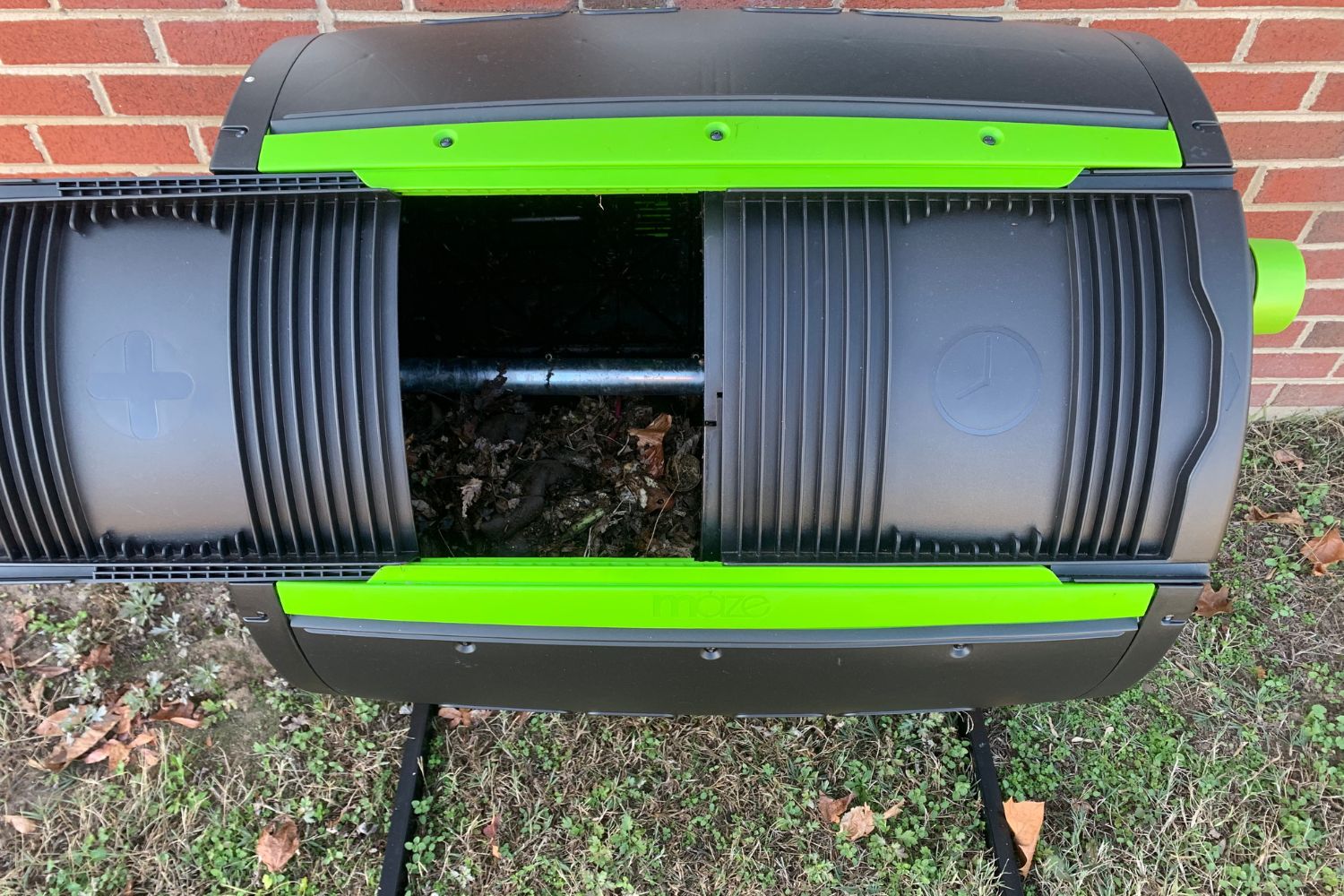
Bin capacity is measured in either gallons or cubic feet; 1 cubic foot equals 7.48 gallons. The smallest compost tumblers hold about 15 gallons, or about 2 cubic feet, while the largest holds more than 80 gallons, or 10.7 cubic feet.
Shoppers will also want to consider the amount of material and how often they want to compost. It takes at least 10 weeks, on average, to process a batch of compost fully. For this reason, many gardeners operate two tumblers simultaneously or use a dual-chamber tumbler. With a dual-chamber bin, users can add to one bin for 10 weeks, then close it, allow it to process, and gradually fill the second bin.
Aeration
Tumbling helps provide air to compost and reduce moisture, both of which are vital in the decomposition process. Look for a compost bin with built-in aeration structures, such as air holes or vents in the walls, fins on the interior walls, flat sides, and mixing bars.
As the material inside breaks down, it can become compacted. Turning the bin loosens the material and breaks down the clumps. Air holes and vents allow the exchange of gas in the microorganisms in the decaying matter and let the excess moisture escape. Flat walls, such as in a hexagonal shape, force the material to tumble rather than slide. Additional texture comes from features such as fins and bars that help stir the material and add oxygen.
Pest Control
An enclosed compost tumbler also helps composters avoid pests like rodents and insects. The lids on these units thread, latch, or slide into tracks, which keep out rodents and other small animals. Durable, heavy-duty plastic is difficult for rodents to chew through, and steel makes the bin virtually impossible to penetrate. Bears even find them challenging, but don’t test that theory! Avoid adding animal favorites, such as meat scraps, bones, and items with high fat content, to the bin.
Odor Control
A foul odor emitting from the bin is an indication that the compost is either not well aerated or that the carbon-to-nitrogen ratio of the compost ingredients is out of balance. Compost tumblers are specially designed to deal with the first issue quickly and easily. Simply rotating the bin once or twice each week infuses oxygen into the mix and promotes the growth of beneficial aerobic-composting microbes. If the compost smells like rotten eggs, it needs air. Spin the bin.
Composting is comparable to keeping a pet, only in this case, the “pets” are millions of aerobic microbes. They need a consistently warm, moist environment with the right kind of “food.” Their food initially consists of about 30 parts carbon to 1 part nitrogen. Nitrogen comes from green compost ingredients like vegetable scraps, coffee grounds, and grass clippings. Carbon comes from so-called brown ingredients, such as autumn leaves, straw, sawdust, and paper. One way to ensure an adequate supply of carbon with kitchen scraps is to include paper products like coffee filters, used paper towels, and tea bags in the mix. When users add new scraps to the bin, they can cover the scraps with shredded newsprint or cardboard.
A properly working compost tumbler should heat up from the activity of the microbes and produce a somewhat sweet, earthy scent. If the ingredients are far out of balance, the microbes cannot process the compost efficiently, possibly causing unpleasant odors. If the mixture is slimy or has an ammonia odor, the nitrogen level is too high. It needs brown ingredients. If too much carbon is in the bin, it won’t heat properly; it needs green ingredients.
Ease of Use
Compost tumblers offer numerous conveniences over stationary compost piles. They’re neat. They enclose the mess for a tidier appearance. Moreover, they are fast and easy to turn. Users only have to spin the tumbler for a minute or two instead of the half hour that it takes to turn a compost pile with a garden fork. Gardeners can move them into a garden shed or garage for efficient winter composting; however, a stationary pile simply goes dormant during cold weather.
Of course, ease of use depends on the individual gardener. To distribute the compost, users can simply dump it from an elevated bin into a wheelbarrow. However, cold-weather gardeners who process compost outdoors may prefer a bin that sits directly on the ground. This is because a tumbler on an elevated frame would be exposed to cold on all sides; the composting process would slow down and stop with the rapid cool down. A bin directly on the ground would be insulated from that effect longer.
But some characteristics appeal to almost everyone. A wider opening makes it easier to load and unload, and, unlike latches and threaded lids, sliding covers rarely get clogged with debris. Exterior handgrips on the bin or a hand crank make it easier to rotate the bin.
The Advantages of Owning a Compost Tumbler
Composting has several benefits, including reducing landfill waste. It also eliminates the need for a truck to drive around picking up materials for off-site composting. Plus, users get to take advantage of their own compost to promote a healthy garden, landscape, and houseplants. It also helps avoid the traditional downsides of composting: the amount of work involved, the mess and odors associated with it, the fear of attracting animal pests, and more. Compost tumblers eliminate these objections.
- Compost tumblers fully enclose the composting process, eliminating the mess and attraction to animals.
- Tumblers make it much easier and faster to aerate compost, eliminating odors and reducing processing time by as much as 50 to 70 percent compared to a compost pile.
- The tumblers can process smaller quantities of waste more efficiently than can compost piles.
FAQs
New to composting? Keep reading to learn more about using and maintaining your new compost tumbler.
Set up the compost tumbler in a sunny location to promote quick growth of composting microbes. Fill it (either all at once or over several weeks) with a mix of kitchen scraps, shredded newspaper, garden debris, grass clippings, fallen leaves, and other scraps. Moisten the mixture (it should feel like a not-quite-saturated sponge) and close the lid.
Rotate the bin according to manufacturer directions. After a week, the ingredients should be warm to the touch, with no foul odors. Continue rotating the bin as indicated and inspect the contents weekly. The temperature will continue to get warmer as the material breaks down, and it will gradually cool as more and more of the material completes the decomposition process. Add water as needed to maintain the moisture level. When it’s cool and appears dark and crumbly with no recognizable particles, the material is completely processed and ready to use.
The time it takes to make compost varies, depending on the temperature, time of year, and the balance of the ingredients inside. It’s possible to have compost within less than 10 weeks if all of the right conditions come together.
For the fastest processing and to eliminate odors, turn the compost tumbler two to three times per week, or more often if the manufacturer recommends it.
The compost should have the feel of a gently wrung-out sponge. As the material is processed and builds heat, moisture evaporates. Check the bin weekly and add water as needed.
Meet the Tester
As a freelance writer, Jenn covers many different topics, including green buildings, natural and sustainable skin care products, natural health remedies, and disease prevention—and she absolutely loves learning about new things through her work.
Additional research provided by Mark Wolfe.

